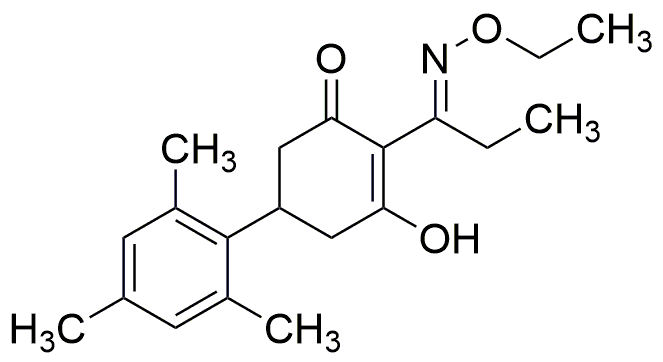Tralkoxydim is widely utilized in research focused on:
- Herbicide Development: This chemical is primarily used as a selective herbicide in agriculture, particularly for controlling grass weeds in broadleaf crops. Its effectiveness helps farmers maintain crop yields without harming the desired plants.
- Crop Protection: Tralkoxydim is incorporated into various crop protection products, providing a reliable solution for farmers to manage weed resistance and improve overall crop health.
- Research in Plant Physiology: Researchers use this compound to study the physiological responses of plants to herbicides, helping to develop more sustainable agricultural practices and improve herbicide formulations.
- Environmental Impact Studies: It is also utilized in studies assessing the environmental impact of herbicides, allowing scientists to evaluate the safety and ecological effects of its use in different ecosystems.
- Formulation Chemistry: The chemical serves as a model compound in formulation chemistry, aiding in the development of new herbicide formulations that enhance efficacy and reduce environmental risks.
General Information
Properties
Safety and Regulations
Applications
Tralkoxydim is widely utilized in research focused on:
- Herbicide Development: This chemical is primarily used as a selective herbicide in agriculture, particularly for controlling grass weeds in broadleaf crops. Its effectiveness helps farmers maintain crop yields without harming the desired plants.
- Crop Protection: Tralkoxydim is incorporated into various crop protection products, providing a reliable solution for farmers to manage weed resistance and improve overall crop health.
- Research in Plant Physiology: Researchers use this compound to study the physiological responses of plants to herbicides, helping to develop more sustainable agricultural practices and improve herbicide formulations.
- Environmental Impact Studies: It is also utilized in studies assessing the environmental impact of herbicides, allowing scientists to evaluate the safety and ecological effects of its use in different ecosystems.
- Formulation Chemistry: The chemical serves as a model compound in formulation chemistry, aiding in the development of new herbicide formulations that enhance efficacy and reduce environmental risks.
Documents
Safety Data Sheets (SDS)
The SDS provides comprehensive safety information on handling, storage, and disposal of the product.
Product Specification (PS)
The PS provides a comprehensive breakdown of the product’s properties, including chemical composition, physical state, purity, and storage requirements. It also details acceptable quality ranges and the product's intended applications.
Certificates of Analysis (COA)
Search for Certificates of Analysis (COA) by entering the products Lot Number. Lot and Batch Numbers can be found on a product’s label following the words ‘Lot’ or ‘Batch’.
*Catalog Number
*Lot Number
Certificates Of Origin (COO)
This COO confirms the country where the product was manufactured, and also details the materials and components used in it and whether it is derived from natural, synthetic, or other specific sources. This certificate may be required for customs, trade, and regulatory compliance.
*Catalog Number
*Lot Number
Safety Data Sheets (SDS)
The SDS provides comprehensive safety information on handling, storage, and disposal of the product.
DownloadProduct Specification (PS)
The PS provides a comprehensive breakdown of the product’s properties, including chemical composition, physical state, purity, and storage requirements. It also details acceptable quality ranges and the product's intended applications.
DownloadCertificates of Analysis (COA)
Search for Certificates of Analysis (COA) by entering the products Lot Number. Lot and Batch Numbers can be found on a product’s label following the words ‘Lot’ or ‘Batch’.
*Catalog Number
*Lot Number
Certificates Of Origin (COO)
This COO confirms the country where the product was manufactured, and also details the materials and components used in it and whether it is derived from natural, synthetic, or other specific sources. This certificate may be required for customs, trade, and regulatory compliance.


